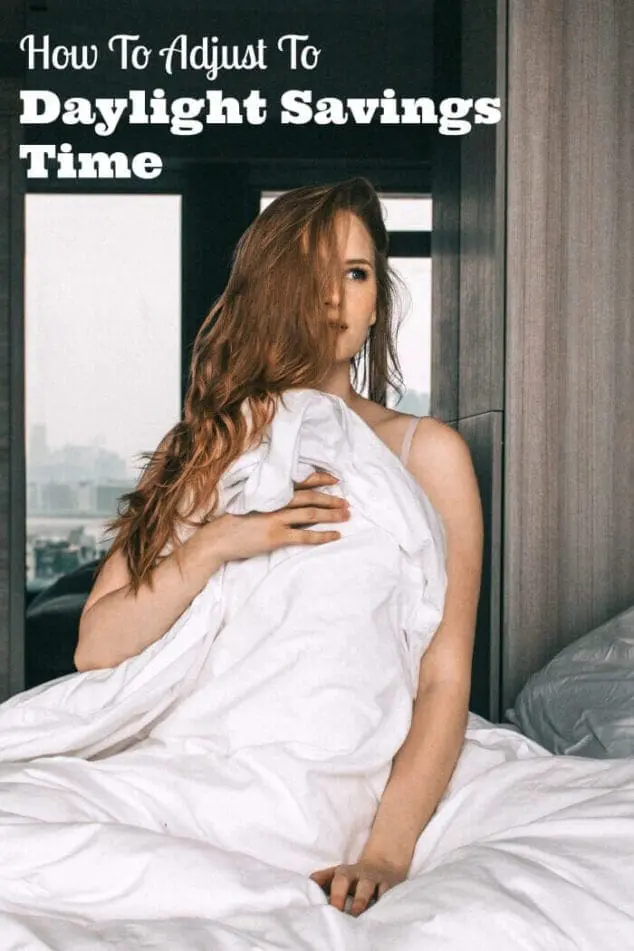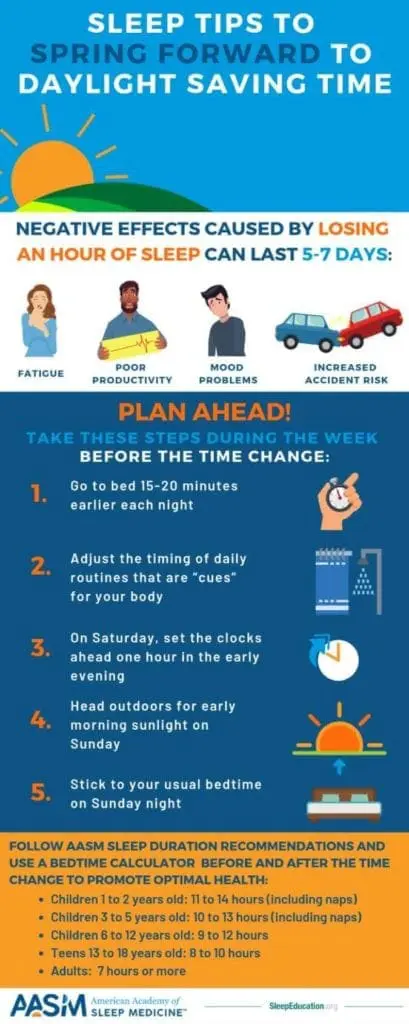The daffodils are beginning to bloom and spring is on its way. I just love this time of year! The only not so fun part is that switching to daylight saving time (DST) on March 10th means losing an hour. If you are one of the millions already sleeping less than seven hours on a regular basis – the amount recommended by the American Academy of Sleep Medicine (AASM) – don’t let it mean losing an hour of sleep. Today I will be sharing tips for how to adjust to daylight savings time without losing sleep which is so important to your health and well being.
This post is sponsored by the American Academy of Sleep Medicine.

What is Daylight Saving Time?
Daylight Saving Time (DST) is a practice of adjusting the clock forward by one hour during the warmer months of the year. The primary purpose of DST is to make better use of daylight during the evenings by shifting an hour of daylight from the morning to the evening. This is done in many regions that experience seasonal changes in daylight, typically lasting from spring to autumn.
During DST, clocks are set forward by one hour in the spring (“spring forward”), usually starting on a predetermined date, and then they are set back by one hour in the fall (“fall back”) to return to standard time. This adjustment is meant to take advantage of longer daylight hours in the evenings, theoretically reducing the need for artificial lighting and potentially saving energy.
Not all countries or regions observe Daylight Saving Time, and the start and end dates can vary between different parts of the world. Some regions have opted out of DST entirely or have chosen to follow different schedules due to various reasons such as energy conservation, agricultural considerations, or public preference.
Tips On How To Help Your Body Adjust to Daylight Savings Time Change
Along with nutrition and exercise, sleep is one of the three pillars of a healthy lifestyle. Missing sleep can be really hard on the body and the mood. As family lifestyle blogger I can tell you that sleep is so important to how we all feel and that how we each feel affects the whole family. But more than that, chronic insufficient sleep can lead to an increased risk of cardiovascular disease, stroke, type 2 diabetes, hypertension, depression, obesity and several types of cancer. The importance of sleep should not be underestimated. That is why it is so important for those who are sleep-deprived to prepare in advance for the spring time change. The key for how to adjust to daylight savings time lies in planning ahead and implementing these tips:
1. Determine A Good Bedtime.
The AASM bedtime calculator can help you “spring forward” and identify an appropriate nightly bedtime for optimal health, productivity, safety and daytime alertness.
2. Slowly Move Bedtime.
Gradually adjust your bedtime 15 or 20 minutes earlier each night beginning two to three nights before the time change.
3. Slowly Move Dinner.
For a few days before the time change, begin to adjust the timing of other daily routines that are “time cues” for your body. For example, start eating dinner a little earlier each night.
4. Do A Saturday Evening Time Change.
On Saturday evening, set your clocks ahead one hour. Then you can go to sleep at your normal bedtime.
5. Get Morning Sunlight.
On Sunday morning, head outdoors for some early morning sunlight to help set your internal clock, which regulates sleep and alertness.
6. Respect The Good Bedtime.
Go to bed early enough on Sunday night to get plenty of sleep (see step 1) before the busy week begins on Monday.
These little things we do really add up to make sure we adjust to daylight savings with ease instead of sleep deprivation. Also don’t forget to cut back on caffeine a little early in the day as daylight savings approaches as that will affect the amount and the quality of sleep we get.

World Sleep Day
World Sleep Day is an annual event to raise awareness of sleep disorders and the burden that they place on society. Join American Academy of Sleep Medicine (AASM) on Friday, March 15, for it’s Twitter Chat! You can learn more about how good sleep is crucial to ensure good health and quality of life and get a chance to win a $100 gift card!
#WorldSleepDay #HealthySleepChat @aasmorg
To learn more about symptoms and treatments for insomnia, sleep apnea and sleep disorders, visit SleepEducation.org
I hope you found these tips on how to adjust to daylight savings time helpful. Let me know if you have any additional tips or a habit that you find useful in adjusting to daylight savings time.
Related Posts:
25 Fun Family Home Evening Ideas
